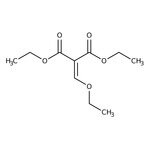Search Thermo Fisher Scientific
Éthoxyméthylènemalonate de diéthyle, 98+ %, Thermo Scientific Chemicals



Éthoxyméthylènemalonate de diéthyle, 98+ %, Thermo Scientific Chemicals
Identifiants chimiques
Spécifications
Description
This Thermo Scientific Chemicals brand product was originally part of the Alfa Aesar product portfolio. Some documentation and label information may refer to the legacy brand. The original Alfa Aesar product / item code or SKU reference has not changed as a part of the brand transition to Thermo Scientific Chemicals.
Le diéthyl éthoxyméthylénemalonate est utilisé pour la synthèse des pyrido[3,2-e]pyrimido[1,2-c]pyrimidines. Initialement, il a été utilisé pour surveiller l’activité de la lysine décarboxylase. Il est utile dans la détermination des acides aminés par dérivation précolonne en utilisant la chromatographie liquide haute performance en phase inverse (HPLC). Il joue un rôle important dans la réaction de Gould-Jacobs pour préparer les quinolines. Par exemple, l’anile réagit avec ce réactif pour donner de la 4-hydroxyquinoline. Il agit comme un intermédiaire dans la production de fluméquine, qui est un antibiotique fluoroquinolone.
Solubilité
Miscible au chloroforme, au dichlorométhane et au méthanol. Immiscible avec l’eau.
Remarques
Incompatible avec les acides, les bases, les agents oxydants et les agents réducteurs.
Figures
Documentation et téléchargements
Certificats
Foire aux questions (FAQ)
Citations et références
Sécurité et manipulation
Classification of the substance or mixture
CLP classification - Regulation(EC) No 1272/2008
Label Elements
Signal Word
Danger
Hazard Statements
H302 - Harmful if swallowed
H317 - May cause an allergic skin reaction
H334 - May cause allergy or asthma symptoms or breathing difficulties if inhaled
Precautionary Statements
P301 + P312 - IF SWALLOWED: Call a POISON CENTER or doctor/physician if you feel unwell
P261 - Avoid breathing dust/fume/gas/mist/vapors/spray
P280 - Wear eye protection/ face protection
P304 + P340 - IF INHALED: Remove person to fresh air and keep comfortable for breathing
P342 + P311 - If experiencing respiratory symptoms: Call a POISON CENTER or doctor/physician